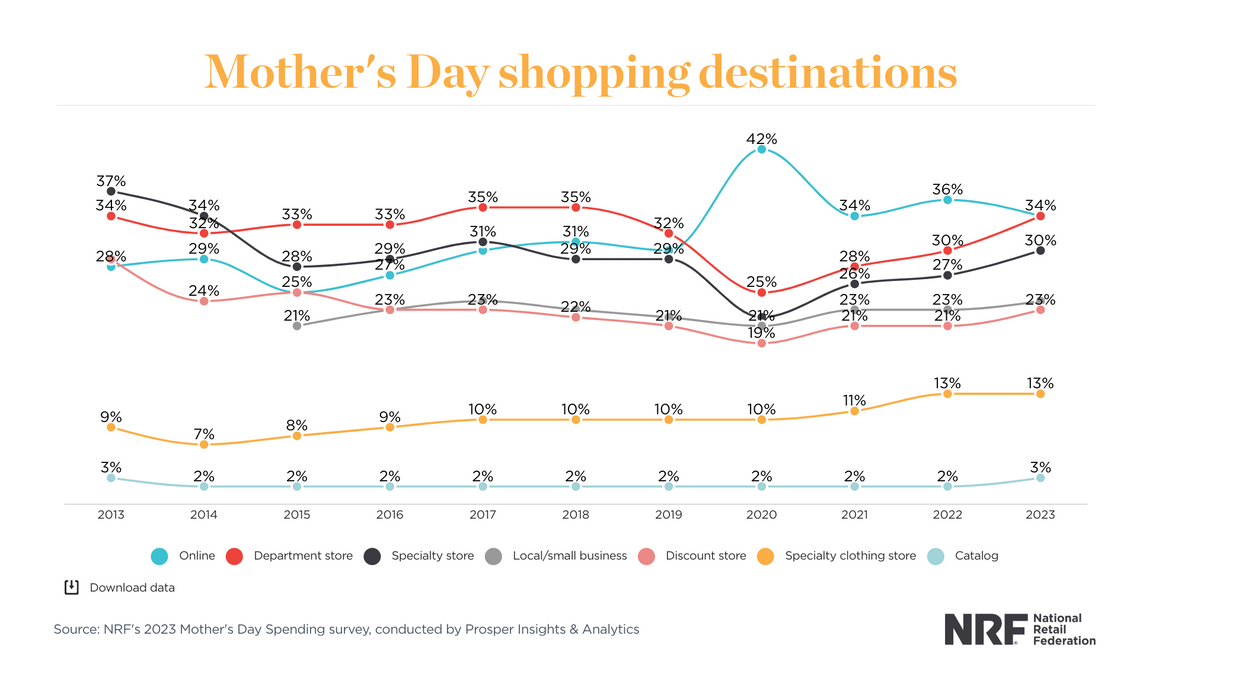Economy
28 April 2023
Mother's Day shoppers are cross-channel, eying subscription boxes
Mother's Day consumer spending is expected to hit a record, according to NRF and Prosper.

Mother's Day shopping destinations. (Courtesy photo)
Mother's Day consumer spending is expected to hit a record, according to NRF and Prosper.

Mother's Day shopping destinations. (Courtesy photo)
Mother’s Day spending is expected to climb to a record of $35.7 billion in 2023, according to a new forecast.
U.S. consumer spending for the May 14 holiday is expected to be nearly $4 billion more than the record of $31.7 billion posted in 2022, the forecast from the National Retail Federation and Prosper Insights & Analytics states.
Here are a few more highlights from the survey of 8,164 U.S. adult consumers, which was conducted April 3-11:
In all, 84% of U.S. adults are expected to celebrate the holiday.
Per-person spending is expected to reach $274.02, which would also be a record.
The top age group is ages 35-44. They expect to spend an average of $382.26.
57% of those purchasing gifts will do so for a mother or stepmother, while 23% will do so for a wife and 12% for a daughter.
The continued emergence from pandemic habits is bringing about more cross-channel shopping for Mother’s Day. The survey found that 34% of consumers are planning to shop online, while the same share are planning to shop in department stores. More consumers are also showing an interest in subscription boxes, as 46% stated they were intrigued by this option, which is up from 39% in 2022.
“While most consumers shopped online last year for the perfect Mother’s Day gift, we are seeing just as many people turn to department stores as a shopping destination this year,” said Prosper EVP of Strategy Phil Rist, in a statement. “Gifts of experience continue to grow in popularity, with nearly one-third of those celebrating Mother’s Day planning to give a gift of experience.”
In popular categories, spending levels are projected to rise across the board, with jewelry, apparel and electronics driving growth. More people are interested in gifting these items than ever, according to the survey. Spending levels in top categories are expected to reach the following:
Labor disputes on the West Coast could cause further disruption heading into peak season.
When the first half of 2023 is complete, imports are expected to dip 22% below last year.
That’s according to new data from the Global Port Tracker, which is compiled monthly by the National Retail Federation and Hackett Associates.
The decline has been building over the entire year, as imports dipped in the winter. With the spring, volume started to rebound. In April, the major ports handled 1.78 million Twenty-Foot Equivalent Units. That was an increase of 9.6% from March. Still it was a decline of 21.3% year over year – reflecting the record cargo hauled in over the spike in consumer demand of 2021 and the inventory glut 2022.
In 2023, consumer spending is remaining resilient with in a strong job market, despite the collision of inflation and interest rates. The economy remains different from pre-pandemic days, but shipping volumes are beginning to once again resemble the time before COVID-19.
“Economists and shipping lines increasingly wonder why the decline in container import demand is so much at odds with continuous growth in consumer demand,” said Hackett Associates Founder Ben Hackett, in a statement. “Import container shipments have returned the pre-pandemic levels seen in 2019 and appear likely to stay there for a while.”
Retailers and logistics professionals alike are looking to the second half of the year for a potential upswing. Peak shipping season occurs in the summer, which is in preparation for peak shopping season over the holidays.
Yet disruption could occur on the West Coast if labor issues can’t be settled. This week, ports from Los Angeles to Seattle reported closures and slowdowns as ongoing union disputes boil over, CNBC reported. NRF called on the Biden administration to intervene.
“Cargo volume is lower than last year but retailers are entering the busiest shipping season of the year bringing in holiday merchandise. The last thing retailers and other shippers need is ongoing disruption at the ports,” aid NRF Vice President for Supply Chain and Customs Policy Jonathan Gold said. “If labor and management can’t reach agreement and operate smoothly and efficiently, retailers will have no choice but to continue to take their cargo to East Coast and Gulf Coast gateways. We continue to urge the administration to step in and help the parties reach an agreement and end the disruptions so operations can return to normal. We’ve had enough unavoidable supply chain issues the past two years. This is not the time for one that can be avoided.”